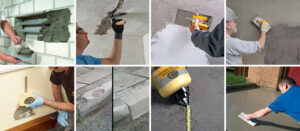How to Repair a Cracked Concrete Structure
To use an effective concrete repair material, you need to know what it is made of. Most repair materials contain the same ingredients as the original mix, but they may contain less water. Less water will make the repair more stable. Dry-pack concrete is less likely to shrink than wet-pack concrete. Other factors to consider when choosing a concrete repair material include the size of the aggregates and the amount of water in the mix. Hopefully, this article will provide you with the answers you need.
When using a repair technique, you must properly prepare the damaged area. Start by removing any crumbling areas of the concrete. A heavy-duty trowel will work, but a cold chisel will have to be used for larger areas. Clean up any loose edges and debris, and hose the area down to a solid base. Concrete Repair professionals can help you avoid costly mistakes that may result in permanent damage.
Once you’ve decided what the problem is, you need to choose a concrete repair material. You can choose a cementitious repair material, one with polymer additives, or an epoxy material. These types of materials can be confusing to choose from. To make sure you get the right product for your project, you should consult a professional in the field. Make sure the concrete repair material you choose matches the existing concrete. If the existing concrete is a good match, you can use a high-quality repair material.
Before repairing a concrete structure, you need to know its strengths and weaknesses. The strength and durability of concrete are good things to remember, but it’s also vulnerable to damage. If the damage is not too significant, you can use concrete repair materials to restore it to a like-new condition. However, if the damage is too significant, you should consider hiring an experienced professional engineer. A good contractor will have a detailed understanding of the materials and techniques that can be applied to repairing concrete.
A crack in a concrete structure is a common sign of damage and should be repaired as soon as possible. This can compromise the structural integrity of your home and cause problems with the foundation. Fortunately, it’s usually less expensive to level a concrete surface than to replace the whole thing. If you’re worried about replacing the entire concrete structure, consider hiring a professional concrete repair company to evaluate its condition and recommend a suitable solution. You’ll be glad you did!
Physical factors are another common cause of concrete damage. These include changes in temperature, the leaching of salts, and wind. Chemical factors can be classified into three basic categories: hydrolysis, erosion, and cavitation. Normal temperature and humidity gradients can cause surface cracking. Exposure to extreme temperature and humidity levels can also cause cracking. In some cases, cracks may be structural, but they’re not always repairable. When cracks in concrete are too deep, they may need to be filled with a new layer of concrete.
Damaged precast products typically have spalling caused by improper handling. This can be structural, performance, or cosmetic. Damaged sections should be examined by a repair evaluation group. If they can’t be repaired, further analysis may be needed. The repairs will depend on the damage and the type of application. However, these factors are not always possible to identify with certainty. Luckily, there are some solutions to the problem that can save you time and money.
Crack sealant is a self-bonding cement mix designed for filling cracks in concrete and stucco. This self-bonding cement filler is available in tubs and 40-pound bags. You can use it to fill medium to large cracks. It is best to use water to help the cement bond properly. This product can be used to repair cracks in concrete, patio, and driveways. However, be sure to follow all the directions carefully.
Another concrete repair product is called a patch. This type of concrete patch can fill deep depressions in concrete surfaces. Moreover, the product is waterproof. It can be applied in layers of up to three inches thick and virtually eliminate large cracks. It is easy to apply and is a good option for minor crack repairs. If you don’t have time to install a whole patch, you can use a concrete patch. The material dries to a light color after curing.
Corrosion occurs when harmful materials penetrate concrete and reach steel reinforcement. During the reaction, anodic current is created. The metal ions then expand and cause internal pressure, which can damage the concrete. Corrosion is one of the leading causes of disfigurement in concrete. This chemical reaction occurs as steel ions react with oxygen and ferrous ions to form rust. A rust-proof concrete repair can reduce the amount of rust by selecting a cement mixture that is specifically designed for harsh environments. Also, a stabilizer can be applied to prevent the coagulation of the colloid suspension.
